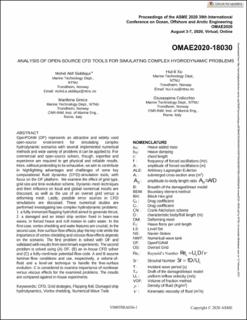| dc.description.abstract | OpenFOAM (OF) represents an attractive and widely used open-source environment for simulating complex hydrodynamic scenarios with several implemented numerical methods and wide variety of problems it can be applied to. For commercial and open-source solvers, though, expertise and experience are required to get physical and reliable results. Here, without pretending to be exhaustive, we aim to contribute in highlighting advantages and challenges of some key computational fluid dynamics (CFD)-simulation tools, with focus on the OF platform. We examine the effect of grid type, grid size and time-evolution scheme. Dynamic-mesh techniques and their influence on local and global numerical results are discussed, as well as the use of an overset grid versus a deforming mesh. Lastly, possible error sources in CFD simulations are discussed. These numerical studies are performed investigating two complex hydrodynamic problems: 1. a fully-immersed flapping hydrofoil aimed to generate thrust, 2. a damaged and an intact ship section fixed in beam-sea waves, in forced heave and roll motion in calm water. In the first case, vortex-shedding and wake features are crucial; in the second case, free-surface flow effects play the key role while the importance of vortex-shedding and viscous-flow effects depends on the scenario. The first problem is solved with OF and validated with results from benchmark experiments. The second problem is solved using (A) OF, (B) an in-house CFD solver and (C) a fully-nonlinear potential-flow code. A and B assume laminar-flow conditions and use, respectively, a volume-of-fluid and a level-set technique to handle the free-surface evolution. C is considered to examine importance of nonlinear versus viscous effects for the examined problems. The results are compared against in-house experiments. | en_US |
